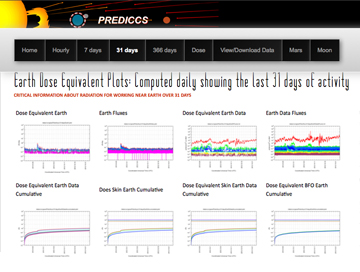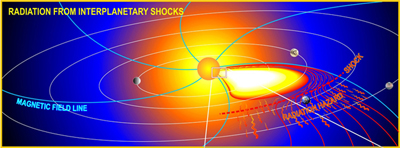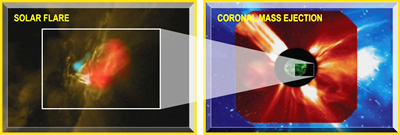Fall 2012
EVEN IF the technology were available to blast astronauts off to Mars, a potential "showstopper" for such a mission would be the potential radiation hazards the intrepid explorers would face on the months' long ride to the Red Planet.
Bombardment from high-energy galactic cosmic rays and solar energetic particles present formidable immediate and cumulative radiation risks for both human and robotic missions beyond low Earth orbit of approximately 1,200 miles.
That's because even miniscule particles like the electrons or protons driven outward from the sun or by cosmic rays to nearly the speed of light can inflict serious damage to any matter they encounter. This can be extremely dangerous for both spacecraft and spaceman working in or passing through the region where "space weather" occurs.
That potential hazard has been tempered by the development of the first online system for predicting and forecasting the radiation environment in near-Earth, lunar, and Martian space environments. The near real-time tool known as PREDICCS will provide critical information as preparations are made for potential future manned missions to the moon and Mars.
"If we send human beings back to the moon, and especially if we're able to go to Mars, it will be critical to have a system like this in place to protect astronauts from radiation hazards," says associate professor of physics Nathan Schwadron of the Space Science Center. "This web-based tool provides awareness about the degree to which deep space poses hazards to spacecraft and astronauts."
Schwadron is the lead developer of the new tool that integrates numerical models of space radiation, a host of near-real-time measurements being made by satellites currently in space, and "propagation codes" that can accurately project radiation levels out as far as Mars. EOS director and astrophysicist Harlan Spence is a co-developer.
The under-the-hood complexity of PREDICCS is matched only by the components that make up its name. The tool could perhaps win an award for the best amalgam of nested acronyms strung together for the sake of "simplicity."
That is, PREDICCS is short for Predictions of radiation from REleASE, EMMREM, and Data Incorporating CRaTER, COSTEP, and other SEP measurements.
To decipher this, let's start at the tail end of this alphabet soup and move backward—all the while introducing yet more acronyms into the mix.
What's in an acro-name?
SEP is the acronym for solar energetic particles—high-energy particles consisting of protons, electrons, and heavy ions with the fastest particles reaching speeds up to 80 percent the speed of light.
COSTEP stands for Comprehensive Suprathermal and Energetic Particle Analyzer—an experiment mounted on the Solar and Heliospheric Observatory (SOHO) spacecraft, which makes a halo orbit around the sun.
The Cosmic Ray Telescope for the Effects of Radiation (CRaTER) is an instrument currently on NASA's Lunar Reconnaissance Orbiter (LRO) and characterizes the global lunar radiation environment and its biological impacts by measuring radiation from behind a "human tissue-equivalent" plastic. CRaTER, whose principal investigator is EOS director Spence, has made the most accurate and comprehensive measurements of radiation at the moon since the dawn of the space age.
The Earth-Moon-Mars Radiation Environment Module (EMMREM) is a UNH-developed model that predicts the real-time radiation environment by combining two other models—the Energetic Particle Radiation Environment Module (EPREM) and the Baryon Transport Module (BRYNTRN)—to nowcast and forecast the radiation environment at various observation points, including the Earth, moon, Mars.
Lastly, the Relativistic Electron Alert System for Exploration (REleASE) very accurately forecasts SEP events up to one and a half hours ahead of the event.
Other satellites that provide measurements used by PREDICCS include NOAA's Geostationary Satellite system GOES spacecraft, the Advanced Composition Explorer, and additional validation from the Ulysses and Mars Odyssey missions.
Know dose
The website provides updates of the radiation environment on an hourly basis and archives the data weekly, monthly, and yearly. This historical record provides a clear picture of when a safe radiation dose limit is reached for skin or blood-forming organs, for example.
Says Schwadron, "What we really need to know is how hazardous this cycle of radiation is. How often do we see large events that have significant risk associated with them? Those questions can only be answered if you're continually building up the database of events and the risk associated with them."
 |
|
| http://prediccs.sr.unh.edu/ |
During several recent large solar events in which the sun, waking from an unusually long quiet period, sent billions of tons of high-energy particles rippling through space, the radiation levels measured by CRaTER as it orbited the moon were matched almost perfectly by PREDICCS.
"For the whopping solar events of January 23 and March 27 of this year, our predictions seem to be within 20 to 30 percent of what was observed, which is incredible. These types of highly accurate comparisons have never been made before," Schwadron says.
Because CRaTER gauges radiation doses using the high-tech plastic that mimics human muscle, not only has it provided the validation that PREDICCS models are accurate, but has done so in the context of how the radiation data would impact human beings on the moon or on a mission to Mars.
"We needed to accurately assess what the biological impacts are to make the best quantitative comparisons between models and observations," says Schwadron, "and having a system like this in place now is sort of like flying a trial balloon in preparation for a return to the moon and a trip to Mars."
The tool's plots of radiation over time can, for example, show that under the right circumstances and even with thick shielding, astronauts in space could approach one-year radiation dose limits well before that year was up. Pointing to a graph line on the PREDICCS website, Schwadron notes that readings taken during solar maximum are just such a case in point.
"If you were up during these periods, these events, even with thick shielding, would definitely cause you to approach the one-year dose limit because they were so large. You wouldn't die, but you would experience some effects —vomiting in extreme cases, fatigue, risk of cancers would go up."
He adds, "So with PREDICCS, for the very first time, people are able to see the effects of space radiation playing out in near real-time, and this opens a new window to an otherwise invisible world."

